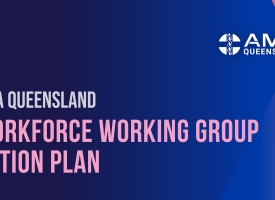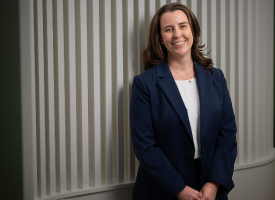State budget an opportunity to boost mental health support
This year's state budget is a good opportunity to invest into mental health services - an area in great need of support, AMA Queensland President Dr Nick Yim told ABC Radio Brisbane. "I'm sure many listeners have struggled to see a psychiatrist, a counsellor or even a psychologist after a GP referral. This is the reason why we need that investment into workforce for psychological health, but also additional psychiatric beds."

Transcript: AMA Queensland President Dr Nick Yim, ABC Radio Brisbane, Drive with Ellen Fanning, Wednesday 14 May
Subjects: Real time hospital data, mental health funding, elective surgery wait times
Real-time hospital data
ELLEN FANNING: I want to talk about hospital waiting times. As I've been saying, remember how the Crisafulli Government promised they'd have a website with real-time data on waiting lists at the state's major emergency departments? Is that working and can you trust what the website's telling you? Dr Nick Yim is the President of the Australian Medical Association Queensland. What's the answer to those questions, Nick?
DR NICK YIM: Good afternoon. So three months ago, the Crisafulli Government introduced the real-time data portal. AMA Queensland, we welcomed that introduction, but we know that with everything with data, we need to ensure it is accurate and made useful for the patients and clinicians who are working on the floor. There has been a little bit of frustration with regards to the data, with regards to the wait times and the perceptions. This is where we're working with the government to tweak around the edges, so we get data on how long it is to wait to get a bed, for example, how many beds are available, how long outpatient wait times are, how long it is to wait for surgeries.
ELLEN FANNING: Are you able to figure out that real-time information and then have a look on the website to see if it's accurate?
DR NICK YIM: At the moment it's pretty new in the system, it's only three months in. So, this is where we're working with the government to ensure that we can have relevant data points that is going to be relevant for the patients and clinicians on the floor.
ELLEN FANNING: Which is a great answer, but not to the question I asked you, which is – is it real? Have they actually figured out a way to reflect on that website, real-time waiting data?
DR NICK YIM: I think they probably haven't worked out the inputs at this point in time. So, at the moment, the data is at time to triage. So, when someone walks through the door, speaks to the triage nurse, that's when it's clicked ‘to be seen’. But we all know, to develop the management plan to wait for the bed, it often takes a little bit longer than that.
ELLEN FANNING: Okay so just to confirm, triage is not when you check in and say ‘I'm here’, it's when you actually see the nurse who says ‘quick, to the front of the queue’ or ‘you just need some stitches, go and sit down and wait for sicker people to be seen’, is that the point?
DR NICK YIM: So that's when they get seen at the front desk, where they make sure that they're not having a heart attack and that they don't have to immediately be taken into the back. It’s so that people who are unwell get seen first before someone in a less urgent situation, for example. They might wait a little bit longer.
ELLEN FANNING: So, basically, going to where we check the various websites, it says an 18-minute wait at Prince Charles, 19-minute wait at Royal Brisbane and Women's Hospital, 21-minute wait at the Queensland Children's Hospital. You're saying that's a wait for a very initial assessment by a nurse?
DR NICK YIM: That's my understanding, because we all know – and when we speak to our patients and our clinicians – that isn't [enough] time to complete treatment, for example. Sometimes it can be significantly longer than those times.
ELLEN FANNING: Okay. And as far as you understood, the commitment the state government made – a website with real-time data on waiting times – does that sort of information about the time you wait to see the initial nurse, not the time for treatment, is that a fair dinkum way to meet that commitment?
DR NICK YIM: I think it's a start, but we can definitely do better with regards to what data we are giving to the patients, the community and to assist our clinicians on the ground.
ELLEN FANNING: Dr Nick Yim is with us, President of the Australian Medical Association Queensland. I'd love your views on this, 1300 222 612. We might dig out the exact wording of the Queensland Government election promise around real-time waiting data at the state's emergency departments, because they did agree to be held to account for that. But as Nick is explaining to us, at this stage, it's only very initial information about how long you wait to actually have a human say, ‘g'day, what's up’, rather than how long it takes you to actually be treated at the hospital. 1300 222 612 is our number. Why is it important to get that sort of up-to-date, accurate data about how long it's going to take to be treated?
DR NICK YIM: So, there's many reasons, and this is the first point with regards to data overall from the hospital-based system. We know that our healthcare system is currently under pressure. AMA Queensland, we've been calling for workforce, we've been calling for hospital beds. But without that data, we don't know – say at Royal Brisbane or Prince Charles – where their pressure points are, for example. If they need more staff during times, 8am to midday, we can allocate staff there. If, for example, a hospital doesn't have enough operating theatres, perhaps they can divert the ambulances to a different hospital. So, this is where real-time data is so important.
ELLEN FANNING: And that's got to be data beyond initial triage, right?
DR NICK YIM: Correct.
ELLEN FANNING: Okay. John’s on the line from Springwood. Thank you for holding on, John. You had a shocking experience at an emergency department recently. Where were you and what happened?
JOHN: It was Logan actually, but I can't find anyone wrong. There was nothing wrong with the ambulance, nothing wrong with the staff or anything else like that. It's just that the whole system seems to be broken. You go to the hospital, you've got two or three ambulance people in attendance with you until you're seen, and that can be hours. It's ridiculous. And then when you finally get seen, you can be spending hours waiting under the control of a nurse or something before you see a doctor. It's just not enough staff at the hospital. I've experienced it with police too, police holding up at the hospital, being held up to wait with a person that's got to be seen.
ELLEN FANNING: I see. So, how long were you waiting, John? Let me know that.
JOHN: It was about nine o’clock when they called the ambulance, and I think it was around seven o’clock that I got to go home.
ELLEN FANNING: Good Lord. Okay, so you were there a full 10 hours.
JOHN: Yeah, around that, yes.
ELLEN FANNING: And without divulging too much about your personal medical information, what were you waiting for?
JOHN: Actually, I'd gone to the doctors for a flu injection, and they said to me, ‘are you healthy’ and everything else like that? I said, ‘yes’, and they said, ‘anything else’? I said, ‘I just had a little bit of twinge a while ago. I think it was a bit of a gastric reflux’. So next thing I know, I'm at the hospital.
ELLEN FANNING: Okay. So, it was just a precaution.
JOHN: Yes, the doctor was playing on the safe side. I didn't think it was anything, but I'm not a medical person. Anyway, it's a shame. It can be a waste of time, not just for me, but for all of them to… I don't know how to explain it. To me, the system is not working properly.
ELLEN FANNING: Did you by any chance have a look at the real-time data on the website about waiting times when you're at Logan Hospital, or was anybody else looking at that data?
JOHN: It's something I never really think about. You know, when you get there, you think about how quick am I going to get out?
ELLEN FANNING: That's right. That's what you want to know. Hey, thanks for sharing that experience. That was John at Springwood there. Dr Nick Yim is on the line, 22 minutes past three on 612 ABC Brisbane. Nick, I've looked up the LNP's commitment back at the last election. Within 100 days, they were talking about real-time data, and they say it's now live, showing the number of patients waiting at hospitals, the busiest times at emergency departments and the number of treatment spaces available. But you're saying to me that you can't see that at all.
DR NICK YIM: Yeah, and this is the great challenge, isn't it? I empathise with John, and this is what we're hearing across Queensland. Ambulances are struggling to offload because they need to ensure that there's a nurse and doctor to offload to, because they need someone to keep an eye on that individual patient. This is one of the big reasons why we need to have that workforce plan to know exactly the number of doctors, nurses, allied health that we need, and to service those beds involved. It's all well and good, but if we don't have the critical workforce to service those beds, it also can be quite challenging.
ELLEN FANNING: But the thing is, that part of the solution – step one, according to the LNP government – was, let's have a bit of transparency and let's not rely on people like John at Springwood to ring up with anecdotes, let's get all this data together. They trumpeted in this press release which was put out on 2 February 2025 that they’d done it in 100 days, that they had this data available. But you're saying to me – well look, it's just not available. It's not there. It's not on the site.
DR NICK YIM: That's one of the key things, we need good data that's usable that we can make healthcare and policy decisions on.
Mental health
ELLEN FANNING: 1300 222 612. What's been your recent experience of going to the emergency department? Did you rely on the government's real-time data, in adverted commas, to let you know waiting times, busiest times at the ED, the number of treatment spaces available at the hospital, and did that accord with reality? 1-300-222-612, 24 minutes past three. Nick, can I just ask you before I let you go, the Crisafulli State Government is due to deliver its first budget in June. Your organisation's starting to lobby for money to be spent on health. Today it was a call for an extra $330 million on top of the $500 million promised by the previous government. Where do you want that money spent?
DR NICK YIM: So that’s one of our key priorities for the Queensland budget. It's a good opportunity for the state government to invest into mental health services. I'm sure you have many listeners that may struggle to see a psychiatrist, a counsellor or even a psychologist, for example, after a GP referral. This is the reason why we need that investment into workforce for psychological health, but also additional psychiatric beds. So that's one of the key priorities that we need.
ELLEN FANNING: So new beds, refurbishing existing beds and growing workforce, which is one of the hardest things to do, isn't it? You can't run hospitals, psychiatric facilities, you can't run any of that without – not to take anything away from your members, doctors – but you can't run them without nurses.
DR NICK YIM: Absolutely. We need that big team. So, it's doctors, nurses, allied health, pharmacists, administration staff. This is one of the big reasons why we continue to call for that workforce attraction incentive. We need to recruit, retain and keep those staff in our state.
Elective surgery
ELLEN FANNING: You also want extra money put into bringing down elective surgery times, or what you better refer to as planned surgery, primarily in the regions, but also, Metro South which covers Logan, the Redlands and the Scenic Rim. What are the waiting times like at the moment?
DR NICK YIM: I’m sure many of your listeners would know that for people waiting for hip replacements, knee replacements, it can be quite lengthy, between months to years. While it is elective surgery, people are in chronic pain. It might be affecting their ability to go to work, to drive or do other activities such as caring for themselves or others, which is the reason why we need to continue to invest into elective surgery. While Surgery Connect has brought down the list, people are still waiting quite long periods in the outpatient department, which is the reason why we need to ensure that we have a sustainable future.
ELLEN FANNING: Yes, so 23 per cent of Category 1 patients ready for surgery are waiting longer than clinically recommended times. And you say, let's get some extra money to drive those times down for planned surgeries, the waiting times?
DR NICK YIM: 100 per cent.
ELLEN FANNING: Good on you, Nick. Thanks for talking to us this afternoon.
DR NICK YIM: I appreciate it, Ellen.



